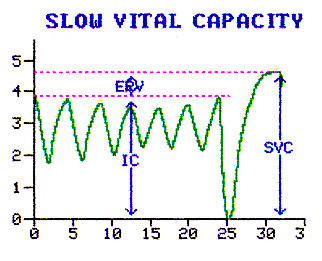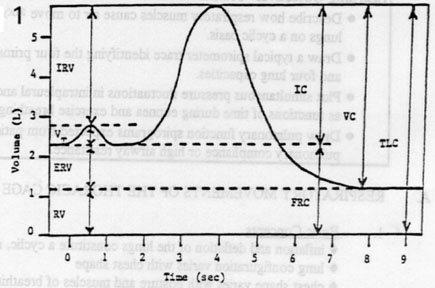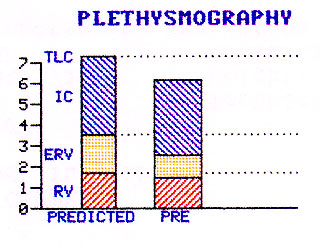IC
ERV
SVC

Slow Vital capacity (SVC)
Total amount of air that can be blown out after a maximal deep breath.
SVC is done leisurely and you can actually take the best inspiratory capacity from one curve and add to the best ERV from another.
FVC is done with the patient expiring as fast as he can.
The normal range is 80-120% predicted.
| TV IC ERV SVC |
 |
| Lung Volumes IC: Inspiratory capacity |
 |
| The normal range for lung volumes are 80-120% predicted. |
Volume Vs Capacity
Total Lung Capacity (TLC)
Total lung capacity can be measured by
In routine PFT interpretation we will be primarily be evaluating TLC by the first three methods.
Plethysmograhy: Measures Slow spaces (Blebs)
Helium dilution: May underestimate slow spaces.
Sinle breath: We will consider it under diffusion measurement.
| Lung Compartments Compare predicted with
observed |
 |
What is normal Vital capacity?
I hope you have not thought of giving me a single number. This query is here to explain predicted and observed columns in the PFT sheet.
What do you think the vital capacity of Michael Jordan! When I was at Northwestern University as a fellow, Dr David Cugell (my mentor) was performing PFT in all of the then Chicago bulls. The values were unbelievable. On the same day there was a 70 year old veteran 4 feet 10 inches tall having PFT. What do you think his vital capacity was!. You got the picture.
Normal PFT values depend on many variables like height, weight, sex etc. A nomogram is developed using a large number of normal people and the value will be compared to that obtained from predicted based on his/her height weight etc. A normal range is 2 standard deviation from mean and it varies from test to test. In general it is 20%. Hence if you are looking at a first PFT you can consider a value as abnormal only if it is outside 2 standard deviation( 80-120%). Hence I always start by looking at percent predicted value to make a decision whether it is in normal range or not. Don't worry about the actual observed value (for now).